What's inside
What's inside
 Key Ingredients
Key Ingredients

 Benefits
Benefits

 Ingredients Side-by-side
Ingredients Side-by-side

Centella Asiatica Leaf Water
Skin ConditioningButylene Glycol
HumectantWater
Skin Conditioning1,2-Hexanediol
Skin ConditioningPanthenol
Skin ConditioningCentella Asiatica Extract
CleansingHydroxyethyl Urea
HumectantAdenosine
Skin ConditioningPolyglutamic Acid
Skin ConditioningMadecassoside
AntioxidantAsiaticoside
AntioxidantCeramide NP
Skin ConditioningSodium Hyaluronate
HumectantGlycerin
HumectantSalix Alba Bark Extract
AstringentHouttuynia Cordata Extract
Skin ConditioningSimmondsia Chinensis Seed Oil
EmollientPhytosteryl/Octyldodecyl Lauroyl Glutamate
Skin ConditioningCaprylic/Capric Triglyceride
MaskingHydrogenated Lecithin
EmulsifyingCarbomer
Emulsion StabilisingSodium Carbomer
Emulsion StabilisingC12-14 Pareth-12
EmulsifyingCentella Asiatica Leaf Water, Butylene Glycol, Water, 1,2-Hexanediol, Panthenol, Centella Asiatica Extract, Hydroxyethyl Urea, Adenosine, Polyglutamic Acid, Madecassoside, Asiaticoside, Ceramide NP, Sodium Hyaluronate, Glycerin, Salix Alba Bark Extract, Houttuynia Cordata Extract, Simmondsia Chinensis Seed Oil, Phytosteryl/Octyldodecyl Lauroyl Glutamate, Caprylic/Capric Triglyceride, Hydrogenated Lecithin, Carbomer, Sodium Carbomer, C12-14 Pareth-12
Snail Secretion Filtrate
Skin ConditioningBetaine
HumectantButylene Glycol
HumectantEthyl Hexanediol
SolventAllantoin
Skin ConditioningPhenoxyethanol
PreservativeSodium Polyacrylate
AbsorbentCarbomer
Emulsion StabilisingWater
Skin Conditioning1,2-Hexanediol
Skin ConditioningSodium Hyaluronate
HumectantPanthenol
Skin ConditioningAdenosine
Skin ConditioningArginine
MaskingCopper Tripeptide-1
Skin ConditioningPalmitoyl Pentapeptide-4
Skin ConditioningAcetyl Hexapeptide-8
HumectantPalmitoyl Tripeptide-1
Skin ConditioningPalmitoyl Tetrapeptide-7
Skin ConditioningSnail Secretion Filtrate, Betaine, Butylene Glycol, Ethyl Hexanediol, Allantoin, Phenoxyethanol, Sodium Polyacrylate, Carbomer, Water, 1,2-Hexanediol, Sodium Hyaluronate, Panthenol, Adenosine, Arginine, Copper Tripeptide-1, Palmitoyl Pentapeptide-4, Acetyl Hexapeptide-8, Palmitoyl Tripeptide-1, Palmitoyl Tetrapeptide-7
 Reviews
Reviews

Ingredients Explained
These ingredients are found in both products.
Ingredients higher up in an ingredient list are typically present in a larger amount.
1,2-Hexanediol is a synthetic liquid and another multi-functional powerhouse.
It is a:
- Humectant, drawing moisture into the skin
- Emollient, helping to soften skin
- Solvent, dispersing and stabilizing formulas
- Preservative booster, enhancing the antimicrobial activity of other preservatives
Adenosine is in every living organism. It is one of four components in nucleic acids that helps store our DNA.
Adenosine has many benefits when used. These benefits include hydrating the skin, smoothing skin, and reducing wrinkles. Once applied, adenosine increases collagen production. It also helps with improving firmness and tissue repair.
Studies have found adenosine may also help with wound healing.
In skincare products, Adenosine is usually derived from yeast.
Learn more about AdenosineButylene Glycol (or BG) is used within cosmetic products for a few different reasons:
Overall, Butylene Glycol is a safe and well-rounded ingredient that works well with other ingredients.
Though this ingredient works well with most skin types, some people with sensitive skin may experience a reaction such as allergic rashes, closed comedones, or itchiness.
Learn more about Butylene GlycolCarbomer is a polymer of acrylic acid. Its main role is to create a gel consistency.
A high amount of carbomer can cause pilling or balling up of products. Don't worry, most products contain 1% or less of carbomer.
Panthenol is a common ingredient that helps hydrate and soothe the skin. It is found naturally in our skin and hair.
There are two forms of panthenol: D and L.
D-panthenol is also known as dexpanthenol. Most cosmetics use dexpanthenol or a mixture of D and L-panthenol.
Panthenol is famous due to its ability to go deeper into the skin's layers. Using this ingredient has numerous pros (and no cons):
Like hyaluronic acid, panthenol is a humectant. Humectants are able to bind and hold large amounts of water to keep skin hydrated.
This ingredient works well for wound healing. It works by increasing tissue in the wound and helps close open wounds.
Once oxidized, panthenol converts to pantothenic acid. Panthothenic acid is found in all living cells.
This ingredient is also referred to as pro-vitamin B5.
Learn more about PanthenolSodium Hyaluronate is hyaluronic acid's salt form. It is commonly derived from the sodium salt of hyaluronic acid.
Like hyaluronic acid, it is great at holding water and acts as a humectant. This makes it a great skin hydrating ingredient.
Sodium Hyaluronate is naturally occurring in our bodies and is mostly found in eye fluid and joints.
These are some other common types of Hyaluronic Acid:
Learn more about Sodium HyaluronateWater. It's the most common cosmetic ingredient of all. You'll usually see it at the top of ingredient lists, meaning that it makes up the largest part of the product.
So why is it so popular? Water most often acts as a solvent - this means that it helps dissolve other ingredients into the formulation.
You'll also recognize water as that liquid we all need to stay alive. If you see this, drink a glass of water. Stay hydrated!
Learn more about Water